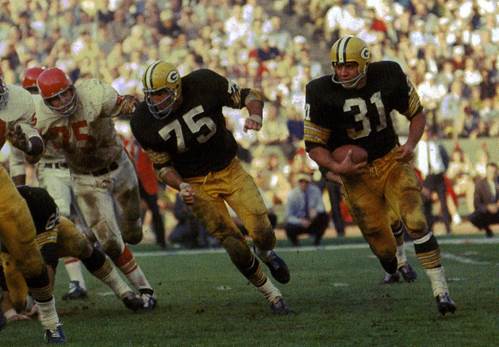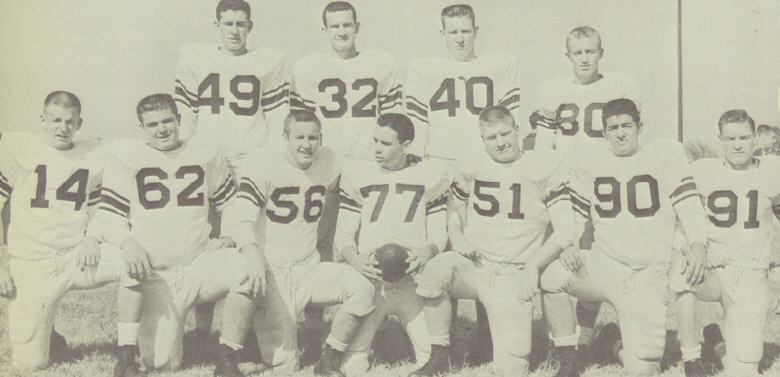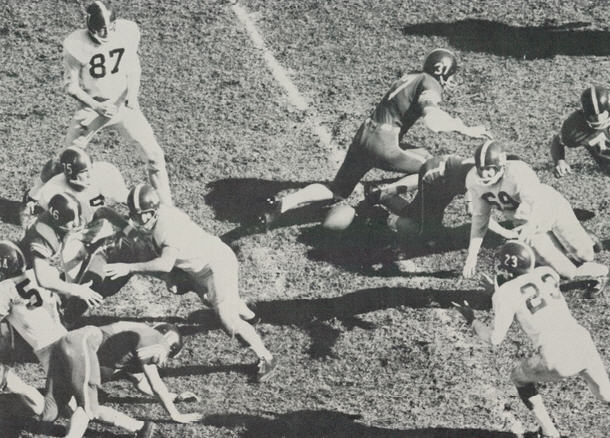

SHERRILL HEADRICK, A MEMORY OF SUPER BOWL 1
HELMET HUT NEWS/REFLECTIONS February 2016:
SHERRILL HEADRICK, A MEMORY
OF SUPER BOWL 1
By Dr. Ken
By choice, I was an “AFL guy” from the inception of the new league in 1960 and until its merger with the National Football League. New York born and bred, I was by all accounts a Giants fan but I had so many favorite players and year-to-year teams for numerous reasons that it was rather easy for me to cheer loudly for the underdog American Football League. I loved the Redskins feather helmets, Don Bosseler, and Johnny O; I thought the exceptionally rough but usually stumbling Steelers with John Henry Johnson, Myron Pottios, and Ernie Stautner were terrific; I admired the precision and success of Jim Taylor and the Packers. I had specific fullbacks I would attempt to copy or emulate throughout high school and included both AFL and NFL greats like Charley Tolar, Taylor, Keith Lincoln, and Bill “Boom Boom” Brown. When the NFL-AFL merger was announced, it did nothing to cool my ardor for the game of football, nor my penchant for supporting various teams in any one season. My loyalties were however, put to the test as the first 1966 AFL – NFL World Championship Game approached.
Now of course, we know this end
of the professional season game
as The Super Bowl and there
aren’t large enough capital
letters to convey the monster
that this game has grown into.
With only 61,946 spectators in
attendance at the inaugural
inter-league match-up, the
mammoth Los Angeles Coliseum
looked rather sparsely
populated. If the football fans
of the nation weren’t yet taken
in by the entire “event” of the
occasion, I was sufficiently
hooked on the importance of the
game to be extremely excited.
 |
Forrest Gregg and Jim Taylor of the Packers on the move against the Chiefs in Super Bowl 1
When most fans, even those from my generation, think about the Kansas City Chiefs and the early Super Bowl years, they most often visualize a great defense featuring linebackers Willie Lanier, Bobby Bell, and Jim Lynch standing behind the bulk of Buck Buchanan, Curly Culp, Jerry Mays, and Aaron Brown. It’s easy to forget that the ’66 defense, which also included Bell, Buchanan, Mays, and Brown, had stars that were perhaps a bit lost to history relative to the lauded ’69 defense, yet extremely effective. One Chiefs player seemingly lost to all but the most ardent AFL fans is linebacker Sherrill Headrick and even now he is frequently noted more for his various anecdotal exploits than his rugged and consistent play.
Most high school offenses of
the 1950’s and early ‘60’s
were fullback oriented. With
many coaches having switched
from the 1940’s Single Wing
that was dominant on both
the high school and college
levels, the T and Split-T
Formations became the
standard. As it has
seemingly been since the
advent of high school
football, the “best athlete”
would often be the team
quarterback but by the
mid-1950’s, it was common to
find the strongest or
toughest boy placed at
fullback, and have him
rotate to linebacker on
defense during the days of
two-way football. Thus many
college coaches would
recruit a disproportionate
number of fullbacks and
convert most of them to
other positions, including
offensive and defensive
guards, or full time
linebackers.

Headrick was an effective
high school fullback on a
mediocre Fort Worth, Texas
North Side High School team
that struggled through a 4-6
1955 season. The senior
fullback and linebacker
earned All District
recognition, but among the
future pros like Don
Meredith, Joe Robb, and
Buddy Humphrey that were
named to the All State Team,
and more heralded Texas high
school players like “Wahoo”
McDaniel, Jack Spikes, and
Don Floyd, he was somewhat
overlooked.
At local Texas Christian
University, Headrick made up
for any perceived lack of
ability by quickly
establishing a reputation as
a punishing player. At
offensive guard and
linebacker, he again may
have been overlooked by many
due to the All American play
of line mate Don Floyd but
by the conclusion of his
junior season in 1958, he
was firmly established as an
All Southwest Conference
performer and potential pro.
Finishing 8-2-1 and with the
Soutwest Conference crown,
the Frogs took their number
ten national ranking into
the Cotton Bowl against the
sixth ranked Air Force
Academy and battled to a
hard-fought 0-0 tie. TCU
head coach Othol “Abe”
Martin looked at the
potential of his ’59 squad
with Floyd, Headrick, and
tackle Robert Lilly up front
and future pros Jack Spikes
and Sonny Gibbs in the
backfield and believed he
would have a winning group.
The 8-3 Horned Frogs did
indeed do well in ’59 with a
number seven end-of-year
ranking but they did it
without Headrick. Earning a
reputation as a passionate
and somewhat reckless player
on and off the field,
Headrick was credited by all
of his teammates as being a
true student of the game.
His penchant for studying
film and opponents continued
into the pros where teammate
Fred Arbanas stated “He was
such a wild man, people
didn’t realize he was such a
student of the game. Teams
would come out in different
formations, and Sherrill
knew exactly where the ball
was going to go.”
Unfortunately, he was not as
passionate about his school
related work and succumbed
to academic problems,
leaving TCU and playing the
1959 season as a defensive
tackle with the British
Columbia Lions of the
Canadian Football League.
Headrick, #69, was an
All SWC guard and
linebacker for the
highly ranked Horned
Frogs
With the formation of
the American Football
League in 1960, Sherrill
Headrick was a natural
for the new league and
signed with the Dallas
Texans. In his eight
seasons with the Texans
and Kansas City Chiefs,
he was one of the most
highly respected players
in the AFL. All AFL in
1960, and an AFL All
Star in ’61, ’62, ’65,
and 1966, he was a
starter his entire
Texans/Chiefs career
that included the Texans
1962 championship team
and the Chiefs Super
Bowl 1 squad. His blitz
and block of a late game
George Blanda field goal
attempt undoubtedly
prevented a loss and led
to the double overtime
1962 championship game
victory. At 6’2” and an
admitted heaviest weight
of 208 pounds, he was
stout against the run,
covered a wide area on
the field, and was
absolutely fearless. He
was so effective in 1962
that many experts later
considered him perhaps
the best linebacker in
all of professional
football during that
season. While his
fifteen career
interceptions (one in
his final, 1968 season
with the Bengals), what
Texans/Chiefs head coach
Hank Stram described as
Headrick’s “great
instincts for a middle
linebacker,” and what
all agreed was an
uncanny ability “at
picking up tendencies
and tips expressed by
offensive teams” made
him a star, it was his
fearlessness and ability
to suppress physical
pain that truly set him
apart.
